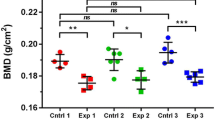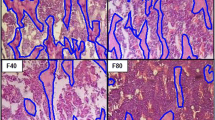Abstract
The anti-fracture efficacy of sodium fluoride (NaF) was evaluated in 84 postmenopausal white women with spinal osteoporosis. The dose of NaF used was 75 mg/day and all patients in this prospective, randomized, double-blind, placebo-controlled clinical trial received calcium supplements (carbonate salt) 1500 mg/day in addition to participating in a structured physical therapy program. For each of the outcome measures (change in stature, change in cortical bone mass in the forearm and development of new vertebral fractures determined by change in vertebral morphometry and by scintigraphy) there was no significant difference between the fluoride or placebo treated groups. Side effects, predominantly gastrointestinal symptoms and the development of the painful lower extremity syndrome, occurred significantly more frequently in the fluoride group (P<0.05). Peripheral fractures were not more frequent in the fluoride group. We conclude that, in the dose and manner used in this study, NaF is no more effective than placebo in retarding the progression of spinal osteoporosis. There is no role for NaF in the treatment of osteoporosis outside the confines of clinical research.
Similar content being viewed by others
References
Riggs BL, Seeman E, Hodgson SF, Taves DR, O'Fallon WM. Effect of the fluoride/calcium regimen on vertebral fracture occurrence in postmenopausal osteoporosis: comparison with conventional therapy. N Engl J Med, 1982; 306: 446–50.
Pak CY, Sakhaee K, Zerwekh JE, Parcel C, Peterson R, Johnson K. Safe and effective treatment of osteoporosis with intermittent slow release sodium fluoride: augmentation of vertebral bone mass and inhibition of fractures. J Clin Endocrinol Metab 1989; 68: 150–9.
Mamelle N, Meunier PJ, Dusan R et al. Risk-benefit ratio of sodium fluoride treatment in primary vertebral osteoporosis. Lancet 1988; ii: 3651–5.
Riggs BL, Hodgson SF, O'Fallon WM et al. Effect of fluoride treatment on fracture rate in postmenopausal women with osteoporosis. N Engl J Med 1990; 332: 802–9.
Dambacher MA, Ittner J, Ruegsegger P. Long-term fluoride therapy of postmenopausal osteoporosis. Bone 1986; 7: 199–205.
Cochran WG. Sampling techniques, 3rd edn. New York: Wiley, 1977: chapter 6.
Laird NM, Ware JH. Random effects models for longitudinal data. Biometrics 1982; 38: 963–74.
Tilley BC, Kleerekoper M, Peterson E, Nelson DA, Schork MA. Designing clinical trials of treatment for osteoporosis: Recruitment and follow-up. Calcif Tissue Int 1990; 47: 327–31.
Kanis JA, Meunier PJ. Should we use fluoride to treat osteoporosis? A review. QJ Med 1984; 53(210): 145–64.
Gruber HE, Ivey JL, Baylink DJ et al. Long-term calcitonin therapy in postmenopausal osteoporosis. Metabolism 1984; 33: 295–303.
Gennari C, Chierichetti SM, Bigazzi S, Fusi L, Ferrara R, Zacchei F. Comparative effects on bone mineral content of calcium and calcium plus salmon calcitonin given in two different regimens in postmenopausal osteoporosis. Curr Ther Res 1985; 38: 455–64.
Schulz EE, Engstrom H, Sauser DD, Baylink J. Osteoporosis: radiographic detection of fluoride-induced extra-axial bone formation. Radiology 1986; 159: 457–62.
Schnitzler CM, Solomon L. Trabecular stress fractures during fluoride therapy for osteoporosis. Skeletal Radiol 1985; 14: 276–9.
Orcel P, Prier A, Crouzet J, Kaplan G. Spontaneous fissures and fractures of the legs in patients with osteoporosis treated with sodium fluoride. Presse Med 1987; 16(12): 571–5.
Schnitzler CM, Solomon L. Histomorphometric analysis of a calcaneal stress fracture: a possible complication of fluoride therapy for osteoporosis. Bone 1986; 7(3): 193–8.
Riggs BL, Baylink DJ, Kleerekoper M, Lane JM, Melton LJ III, Meunier PJ. Incidence of hip fractures in osteoporotic women treated with sodium fluoride. J Bone Miner Res 1987; 2(2): 123–6.
Gutteridge DH, Price RI, Nicholson GC et al. Fluoride in osteoporotic vertebral fractures: Trabecular increase, vertebral protection, femur fractures. In: Christiansen C et al., eds. Osteoporosis. Glostrup, Denmark: Osteopress 1984; 705–7.
Hedlund LR, Gallagher JC. Increased incidence of hip fractures in osteoporotic women treated with sodium fluoride. J Bone Miner Res 1989; 4: 223–5.
Rich C, Ensinck J. Effect of sodium fluoride on calcium metabolism of human beings. Nature 1961; 191: 184–5.
Author information
Authors and Affiliations
Rights and permissions
About this article
Cite this article
Kleerekoper, M., Peterson, E.L., Nelson, D.A. et al. A randomized trial of sodium fluoride as a treatment for postmenopausal osteoporosis. Osteoporosis Int 1, 155–161 (1991). https://doi.org/10.1007/BF01625446
Received:
Accepted:
Issue Date:
DOI: https://doi.org/10.1007/BF01625446




